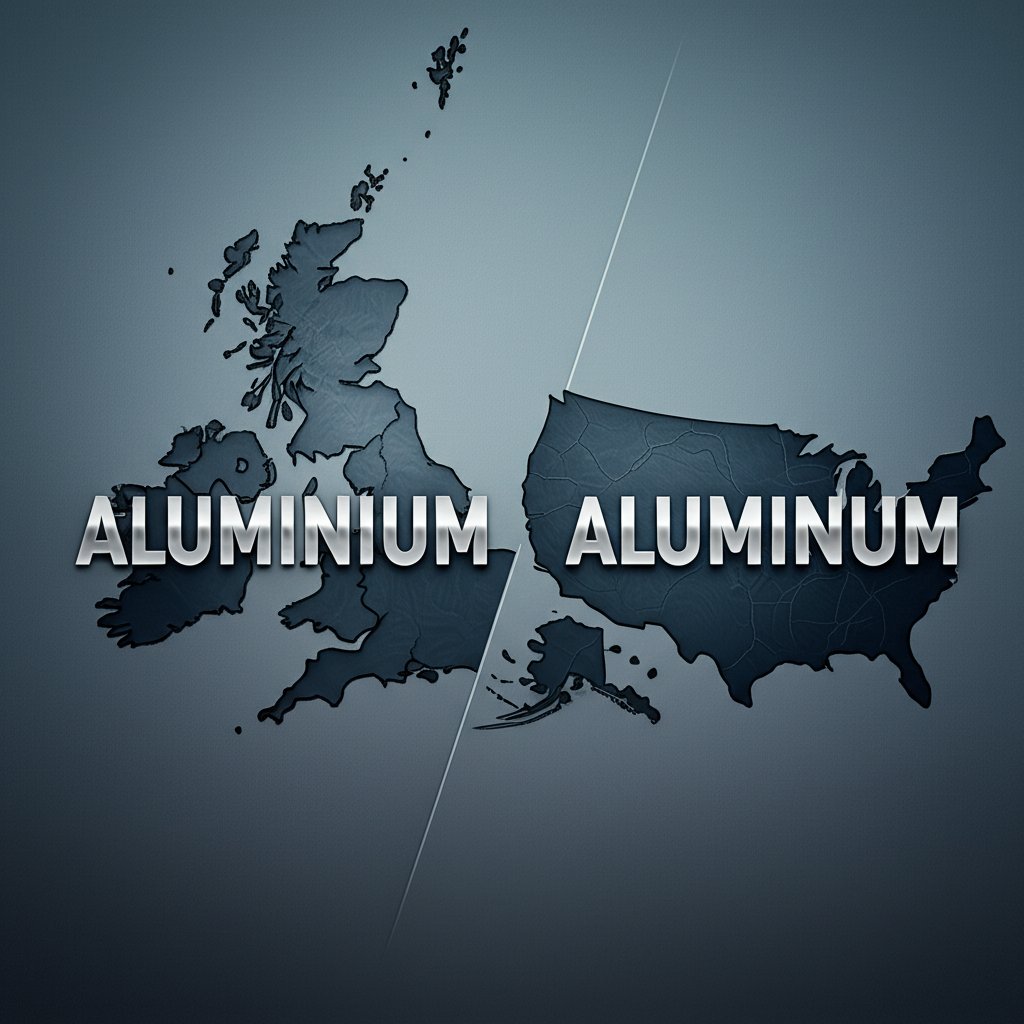
Ever found yourself wondering if it’s aluminum or aluminium? You’re definitely not alone. Whether you’re reading a technical document, shopping for kitchen foil, or working in international business, the difference between aluminum and aluminium is a source of ongoing curiosity and, sometimes, confusion. Is it just a matter of spelling, or is there more beneath the surface?
Let’s clear the air: aluminium vs aluminum isn’t about two different metals. It’s about how the same element is referred to in different parts of the world. In the United States, you’ll see “aluminum” everywhere—from soda cans to engineering specs. In the UK and most other English-speaking countries, “aluminium” is the accepted form. Sounds complex? It’s actually a fascinating story of language, science, and culture coming together.
The metal is the same; the spelling tells a story of language and location.
So, is it aluminum or aluminium? The answer depends on where you are and who you’re talking to. The aluminum versus aluminium debate is rooted in history, stretching back to the early 19th century and involving chemists, dictionaries, and even international scientific organizations. Understanding this background is key to appreciating why both spellings are still in use today—and why they both matter.
In the chapters ahead, we’ll explore the origins of these spellings, the role of scientific authorities, and why the aluminum vs aluminium question is more than just a matter of vocabulary. Whether you’re a student, a professional, or simply curious, you’ll gain a deeper understanding of how language shapes our view of the world’s most abundant metal.

Ever wondered why you see both "aluminum" and "aluminium" in textbooks, on packaging, or in technical documents? The answer lies in a fascinating journey through science, language, and industry. Let’s unravel the story behind the difference between aluminum and aluminium by taking a closer look at the people, discoveries, and decisions that shaped how we spell—and say—the name of this remarkable metal.
To understand who discovered the aluminum element, we travel back to the early 19th century. English chemist Sir Humphry Davy was at the forefront of scientific innovation, using new electrolysis techniques to isolate elements never before seen in pure form. While alum salts (used in alum block for shaving and water purification) had been known for centuries, it wasn’t until 1808 that Davy isolated the metallic element from alumina, the oxide found in nature. But what should he call it?
This divergence wasn’t just a quirk of language—it reflected broader trends in scientific naming and international communication. As the metal became more commercially valuable, especially after the invention of cost-effective extraction methods in the late 19th century, standardization became more important. Yet, the split persisted, and both terms found their place in dictionaries and industry standards around the world.
For those seeking interesting information about aluminum, it’s worth noting that pure aluminum does not occur naturally—so, in a sense, is aluminum man made? Yes, the element must be extracted from minerals like bauxite using advanced chemical processes, a feat only possible with the advent of modern chemistry and electricity. This makes the story of its discovery and naming even more remarkable.
Today, whether you call it "alumini," "aluminum," or "aluminium," you’re referencing a metal with a rich history, shaped by scientific breakthroughs and linguistic choices. From its early use in alum block to its starring role in aviation and packaging, the journey of this metal is filled with fun facts about the element aluminum—from being once more valuable than gold to becoming one of the world’s most recycled materials.
If you’re eager to dive deeper into the spelling debate, don’t miss this detailed exploration: Is it Aluminum or Aluminium? Clearing Up the Spelling Confusion.
Now that you know where aluminum comes from and how its name evolved, let’s explore how scientific authorities finally settled the debate—at least on paper—in the next section.
So, who actually decides if it’s aluminum or aluminium? After learning about the metal’s naming saga, it’s natural to wonder if there’s an official answer. This is where global scientific authorities step in—especially the International Union of Pure and Applied Chemistry (IUPAC).
Let’s start with the basics: is aluminum an element? Absolutely. In fact, aluminum is an element with atomic number 13, and it’s represented by the symbol “Al” on the periodic table. It belongs to the group of basic metals and is known for its versatility and abundance in the Earth’s crust.
But what about the spelling? In 1990, IUPAC—the global authority for chemical nomenclature—officially adopted “aluminium” as the standardized name for the element for aluminum worldwide. This decision aimed to create consistency across scientific literature and align with naming conventions for other metals ending in “-ium,” such as sodium and magnesium.
This means that, in international chemistry and academic contexts, “aluminium” is the recognized term. If you’re reading a scientific paper or a global standards document, you’ll almost always see “aluminium” used for element alu.
Why did IUPAC make this choice? Imagine you’re a researcher collaborating across borders. Standardized terms help avoid confusion, especially when discussing elements with similar names or properties. The “-ium” ending brings “aluminium” in line with other metallic elements, making it easier for scientists to communicate clearly and consistently.
However, it’s important to note that the United States continues to use “aluminum” in most contexts—and this spelling is still accepted as a variant by IUPAC for American publications. So, while “aluminium” is the global scientific standard, “aluminum” remains deeply rooted in American industry, education, and everyday language (Science Notes: Aluminum Facts).
In summary, is aluminum a element? Yes, and while the spelling may vary, the science remains the same. The next time you encounter either form, you’ll know the story behind the word—and why global standards matter in science and industry alike.
Curious about where “aluminum” and “aluminium” are used around the world? Let’s map out the spelling conventions by region in the next section.

When you travel, read international publications, or work with global teams, you’ll notice that the aluminium vs aluminum debate is far more than just a US/UK split. The difference between these spellings reflects deep-rooted linguistic traditions and practical standards that vary by region. If you’re drafting technical documents, managing supply chains, or simply curious about language, understanding who uses which spelling—and why—can help you communicate more clearly and avoid confusion.
Imagine you’re reviewing a contract for aluminio components in Spain, reading a Canadian engineering report, or labeling a shipment for Australia. Which version should you use? Here’s a practical breakdown of aluminium or aluminum by region:
| Region/Country | Predominant Spelling | Notes/Context |
|---|---|---|
| United States (US) | Aluminum | "Aluminum" is standard in all contexts—industry, education, and government. The term "american aluminum" is widely recognized and used in technical and consumer documents. This is the classic example of aluminum american spelling. |
| United Kingdom (UK) | Aluminium | The preferred spelling in science, industry, and daily use. This is the "aluminum british" convention, used consistently in British publications and official documents. |
| Canada | Aluminum (mostly) | Canadian English generally follows the US spelling, so "aluminum" is most common. However, "aluminium" can appear in formal or British-influenced contexts, especially in academia or multinational settings. |
| Australia & New Zealand | Aluminium | "Aluminium" is the standard in all official, educational, and industrial usage. This aligns with the broader Commonwealth tradition. |
| India | Aluminium | "Aluminium" is the official and common spelling in technical, academic, and commercial documents. |
| European Union | Aluminium | "Aluminium" is used in all EU languages that borrow the English term. The spelling matches international scientific standards and is found in EU legislation and trade documents. |
| Spanish-speaking countries | Aluminio | While not an English spelling, "aluminio" is the direct translation and universally used in Spanish-language contexts for the same element. |
This table shows that the choice between aluminum american spelling and aluminium british spelling isn’t arbitrary—it’s about aligning with local standards and audience expectations. For example, if you’re exporting us aluminum products to the UK, updating your documentation to "aluminium" can help prevent misunderstandings. Likewise, Canadian companies often use "aluminum" in North American trade but may switch to "aluminium" when dealing with European partners.
Ultimately, both spellings are correct in their respective regions. The key is to be consistent and aware of your audience. This attention to detail is especially important in technical writing, international business, and academic publishing, where clarity and credibility are essential.
Next, we’ll explore how these spelling differences also shape the way the element is pronounced—another layer of the global aluminium vs aluminum story.
Ever paused mid-sentence, wondering if you’re saying “aluminum” the right way? Or maybe you’ve heard someone from the UK say “aluminium” and thought it sounded a bit longer? The pronunciation aluminum debate is almost as lively as the spelling one, and knowing how to pronounce aluminum or aluminium correctly can help you communicate more confidently—especially in international settings.
The difference boils down to both spelling and regional speech patterns. If you’ve ever asked yourself, “How do you pronounce aluminium?” or “What’s the correct aluminum pronunciation?”, you’re in good company. Let’s break down the essentials so you can sound natural, no matter your audience.
Notice the extra syllable in the British version? That’s the most obvious difference. The aluminium british pronunciation adds an extra “i,” resulting in that distinct five-syllable rhythm. In contrast, the American pronunciation is shorter and more direct. If you’re trying to master the pronunciation of aluminum for a US audience, remember to drop that extra syllable; if you’re speaking with British or international colleagues, adding it will sound more natural.
But why do these differences exist? As with spelling, pronunciation evolved over centuries of language change and cultural exchange. According to linguistic research, American English tends to favor streamlined pronunciations, while British English often preserves older or more classical forms (Kwintessential).
So, next time you’re in a meeting or writing a presentation, consider your audience. If you want to pronounce aluminum like an American, keep it at four syllables. For the aluminium british pronunciation, add that extra “i” and syllable for a truly international touch.
Understanding these subtle differences in how to pronounce aluminum or aluminium not only helps you sound more polished but also bridges communication gaps in global teams. In the next section, we’ll move beyond language and look at the shared scientific properties that unite both spellings.
.jpg)
Whether you call it “aluminum” or “aluminium,” the science doesn’t change. The element behind both names is exactly the same, and its properties are what make it indispensable across industries—from aerospace to packaging. But what exactly defines this metal at the atomic level? Let’s look beyond the spelling debate and focus on the characteristics that have made it the world’s most widely used nonferrous metal (Britannica: Aluminum).
Imagine you’re designing an aircraft, choosing cookware, or selecting materials for high-voltage power lines. What makes this element stand out isn’t just its abundance, but a unique combination of physical and chemical traits. The aluminum periodic table symbol—“Al”—is your gateway to a deeper understanding of what makes this metal so versatile.
To help you quickly compare and reference, here’s a table summarizing the essential properties of aluminum/aluminium. This data is crucial for engineers, scientists, and anyone seeking technical details about the element itself:
| Property | Value | Notes |
|---|---|---|
| Atomic Number | 13 | Defines its place on the periodic table. |
| Aluminum Periodic Table Symbol | Al | Universal chemical symbol for the element. |
| Atomic Weight (Molar Mass) | 26.98 | Measured in atomic mass units (u). |
| Density of Aluminum | 2.70 g/cm³ | About one-third the density of steel or copper. |
| Melting Point | 660°C (1,220°F) | Relatively low, aiding casting and forming processes. |
| Boiling Point | 2,467°C (4,473°F) | High thermal stability for demanding applications. |
| Heat Capacity of Aluminum | 0.900 J/g·K | Excellent for heat transfer uses. |
| Aluminum Electron Configuration | 1s22s22p63s23p1 | Explains its typical +3 oxidation state. |
| Crystal Structure | Face-centered cubic (FCC) | Contributes to its ductility and malleability. |
| Electrical Conductivity | About 63% of copper | Lightweight alternative for power lines. |
| Thermal Conductivity | ~237 W/m·K | Roughly half that of copper, but still excellent. |
| Corrosion Resistance | High | Forms a protective oxide layer naturally. |
So, why do these numbers matter for the ongoing aluminum versus aluminium discussion? They highlight that, regardless of how you spell it, the metal’s technical identity is constant. The low aluminum density makes it perfect for transportation and packaging, while its high heat capacity of aluminum and corrosion resistance make it invaluable in cookware and outdoor structures. The aluminum melting point ensures it can be shaped into everything from beverage cans to airplane parts without compromising strength.
And if you ever need to check its place on the periodic table, just look for the aluminum periodic table symbol: Al. It’s a reminder that, behind every regional spelling, the science remains universal.
Now that you know what makes this element unique at the atomic and practical level, let’s see how these unchanging properties play a role in industry—and why using the right term can help avoid confusion in global projects.

Imagine you’re an engineer sourcing aluminum sheets for an international project, or a procurement manager drafting a contract for alu sheets with a supplier overseas. At first glance, the aluminium vs aluminum debate might seem like a minor detail, but in technical fields, these distinctions can have real-world consequences. Let’s explore why spelling matters beyond the dictionary—and how it can affect everything from technical documents to global business deals.
In industries like aerospace, construction, and manufacturing, precision in language is as important as precision in measurement. Technical documents—such as blueprints, purchase orders, and material data sheets—must be unambiguous. The difference between aluminum and aluminium isn’t just academic; it’s a cue to your audience about the standards you follow and the market you’re addressing.
Let’s look at a real-world scenario: A US-based aerospace firm is collaborating with a UK engineering partner on a new aircraft component. The American team submits drawings for “aluminum sheets,” but the British partner’s procurement system only recognizes “aluminium sheets.” If both sides aren’t vigilant, this could result in delays, duplicate orders, or the wrong material being shipped. By clarifying terminology up front, teams can prevent confusion and keep projects on track.
Similarly, multinational companies often establish internal language guidelines to standardize communication. For instance, a global automotive supplier may mandate the use of “aluminium” in all technical documents except those intended for the US market, where “aluminum” is required. This approach streamlines quality control and reduces the risk of errors in production or compliance audits (Scholardox L2).
So, how can you avoid misunderstandings and ensure smooth collaboration in the world of aluminium vs aluminum?
In summary, the spelling you choose sends a signal about your professionalism and attention to detail. While “aluminum” and “aluminium” refer to the same metal, their usage can impact everything from supplier relationships to regulatory compliance. By understanding these nuances, industry professionals can communicate more effectively and keep global projects running smoothly.
Next, we’ll wrap up with practical advice for global sourcing and choosing the right partner, ensuring your materials—and your terminology—meet the highest standards.
After exploring the spelling, history, science, and industry standards behind aluminium vs aluminum, you might still wonder: what matters most when making decisions for your business or project? The answer is simple—context and quality.
If you’re working with American clients or suppliers, “aluminum” is the clear choice. For most other English-speaking countries and in international scientific or technical contexts, “aluminium” is the standard. This awareness of your audience ensures your documents, contracts, and communications are clear and professional. But while spelling is important, it’s not the only factor that determines project success.
Imagine you’re sourcing 4/0 aluminum wire for a large-scale construction project or evaluating aluminum powder for advanced manufacturing. You need more than just the right spelling—you need a supplier who understands the nuances of global standards, regional terminology, and the technical requirements of all metals in your supply chain. This is where the concept of alu metallic quality comes into play: it’s not just about the name, but the consistency, performance, and certification of the material you receive.
For industries ranging from transportation and construction to electronics and packaging, partnering with a supplier who is fluent in both the language and the science of aluminum/aluminium is essential. Many global firms turn to experts like Shengxin Aluminum, whose deep experience across all metals and commitment to international standards ensures that your materials meet the highest benchmarks—no matter what you call them.
In summary, while the aluminium vs aluminum debate is rooted in history and language, your success in global sourcing depends on clear communication and uncompromising quality. Choose terminology that fits your audience, but always prioritize a supplier who delivers certified, high-performance alu metallic solutions for every application.
The two spellings reflect historical and regional preferences. 'Aluminum' is used mainly in the United States, while 'aluminium' is the standard in the UK and most other English-speaking countries. The naming evolved from early scientific debates, with both versions tracing back to Sir Humphry Davy's work in the 19th century.
International scientific organizations, including IUPAC, officially recognize 'aluminium' as the standard name for element 13. However, 'aluminum' is still accepted in American scientific and industrial contexts, making both spellings valid depending on the region.
No, the spelling difference does not affect the metal’s physical or chemical properties. Whether called aluminum or aluminium, the element (symbol Al) remains identical and is used for the same industrial and scientific applications worldwide.
Use 'aluminum' for American audiences and 'aluminium' for British, Commonwealth, and international contexts. Consistency within documents and alignment with regional standards are key, especially in technical, legal, or trade materials.
Choose a supplier with expertise in international standards and terminology, like Shengxin Aluminum. They provide high-quality alu metallic products and understand the importance of clear communication and certified materials for global projects.
 online service
online service 0086 136 3563 2360
0086 136 3563 2360 sales@sxalu.com
sales@sxalu.com +86 136 3563 2360
+86 136 3563 2360